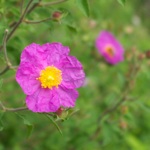Cistus creticus
Synon. Cistus incanus ssp. creticus
Rockrose Αγκίσαρος

Cistaceae - Rockrose Family Dicot.
Cistus creticus
Synon. Cistus incanus ssp. creticus
Rockrose Αγκίσαρος

Cistaceae - Rockrose Family Dicot.
Cistus maquis is a common sight in the Islands of the Northern Sporades covering large areas in forest clearings, particularly in areas where the forest has been destroyed by fire. For most of the year the low growing bushes are a rather dull, grey-green but in late spring they burst into bloom. They are now scattered with brilliant pink (C. creticus) or white (C. salvifolius).
The pink form, C. creticus, has bright pink petals which appear to have been made from crinkled tissue paper. The petals surround a multitude of gold stamens which in turn surround a gold stigma. They are very attractive to bees. The bushes occur singly by the roadside, on the edges of fields or olive groves as well as in the forest.
The leaves are hairy and have a sticky feel due to the exudation of a gum labdanum.
✿↕3.5-5cm⤴40-120cm JAN FEB MAR APR MAY JUN JUL AUG SEP OCT NOV DEC
Labdanum
The Myrrh of the bible
Labdanum (ladanum) is the sticky substance exuded by the hairs of the leaves of cistus to protect the plants from the heat of the sun. The substance dries to form a fragrant dark brown resin, thought by some to be the myrrh of the bible.
The main plant sources of labdanum are C.creticus ssp. creticus and C. ladanifer, named after the resin. It was first used by the Egyptians as burned as incense in temples, for embalming mummies.The upturned beards of the pharos were goats hair dressed with landanum. In past times the substance was collected by goats.The animals were herded into the bushes, and the sticky labdanum collected on their legs and beards. A Czech plant collector Franz Sieber, who travelled to Crete in 1817, described how "country fellows in their shirts and drawers" collected the resin by drawing whips through the plants in the heat of the day.1
The valuable substance is still used in perfumes and cosmetics and gathered commercially in Crete using a curious implement, a ladanisterion.
For more info. visit the fascinating Cretan blogspot by clicking image.
1. John Claudius Loudon. Arboretum et Fruticetum Britannicum...1854.
"...glistening and shaded olive trees and many nameless flowers on the mountain. Cistus? Arbutus? A bush with fragile pink flowers."
Peter Levi. The Hills of Kronos..

